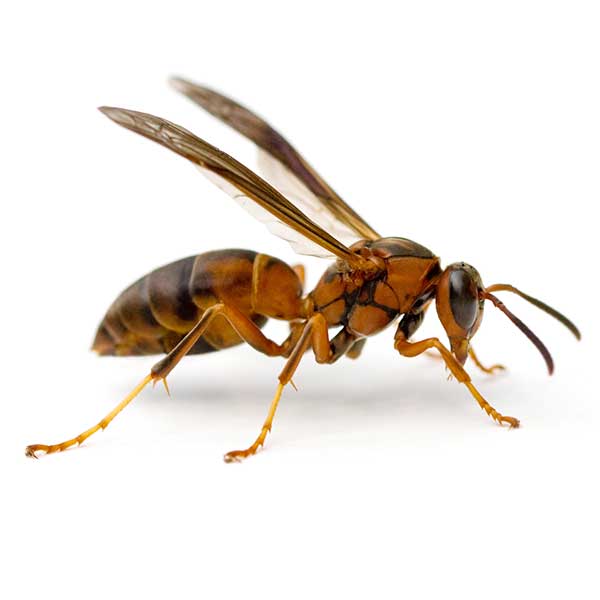Pest Description
Paper Wasps
Paper Wasps are the most docile of the three main social species. They tend to only become problems when they build their umbrella-shaped nests directly over doorways or other areas (such as under a picnic table) where close human interaction cannot be easily avoided. The nests, in which the egg cells open down, usually range in size from 15 to 50 cells. These wasps are long-legged, elongated, and slender-waisted. To the casual observer they may appear to be black but are most likely golden brown, or darker, with large red or yellow patches. As they are not usually aggressive and are beneficial, (helping to control fruit destroying insects and flies) eliminating the nests is usually not necessary.
Biology of Paper Wasps
All wasps fall under the beneficial insect category in that they pollinate flowers and are predators of flies, caterpillars, aphids, and other insect pests. However, for people who are allergic to the stings, the problems far outweigh the benefits, and proper means must be taken to avoid being stung. This is not to say for those of us who are not allergic should be unconcerned about getting stung. Even if you are not allergic you will most likely experience quite a bit of pain after a sting. It is best for people who are known to be sensitive to stings to consult a professional to rid homes, businesses and yards of pests.
In order to identify these pests it is helpful to understand each of the following pest’s nature and lifecycle. The social wasps (i.e. Yellowjackets, Hornets, and Paper Wasps) are ones that we see most frequently. The easiest way to distinguish the difference wasps is to look at the size of the wasp and the pattern on the abdomen. Most workers will survive only a season while reproductive wasps will survive over winter and start up each spring depending on weather conditions.
Removal & Control of Paper Wasps
Stinging insects such as Wasp, hornets and bumble bees can be a serious pest problem for some customers if the nest is located in an area where there is pedestrian traffic. A trained pest management professional is crucial to resolving your stinging insect problems. Comprehensive stinging insect service includes three steps:
- Inspection. A thorough inspection and interview with the customer can determine the level of activity in and around the structure as well as specific location(s) of nesting sites. Based on the technicians findings and information from the customer we can make a proper diagnosis of the treatment strategy as well as recommendations for prevention in the future.
- Treatment. Typical treatment options may include outside application and/or removal of the nest to alleviate immediate concerns from pest pressures in and around the structure as well discourage infestations in the near future.
- Follow-up. Treatment for wasps, hornets and other stinging insects can be very effective. However, due to the relative short lifespan of environmentally friendly products, regular follow-up treatments are recommended to protect the home against future infestations. Quarterly perimeter treatments around the exterior of the home are a great way to ensure your home stays free from infestations as well as help with other pest issues in and around your home and/or structure.









